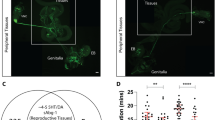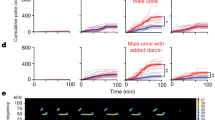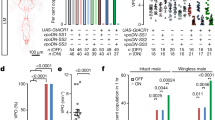Abstract
In male Drosophila, chemosensory cues control many aspects of social behavior. We found that males with a mutated Gustatory receptor 32a gene (Gr32a) show high courtship toward males and mated females, indicating that GR32a functions as a pheromone receptor for a male inhibitory pheromone. Notably, we discovered that tarsal Gr32a-expressing neurons were essential for courtship suppression and projected to the ventrolateral protocerebrum, implying direct communication of chemosensory neurons with a higher-order brain structure.
This is a preview of subscription content, access via your institution
Access options
Subscribe to this journal
Receive 12 print issues and online access
$209.00 per year
only $17.42 per issue
Buy this article
- Purchase on Springer Link
- Instant access to full article PDF
Prices may be subject to local taxes which are calculated during checkout



Similar content being viewed by others
References
Amrein, H. Curr. Opin. Neurobiol. 14, 435–442 (2004).
Bray, S. & Amrein, H. Neuron 39, 1019–1029 (2003).
Ejima, A. et al. Curr. Biol. 17, 599–605 (2007).
Kurtovic, A., Widmer, A. & Dickson, B.J. Nature 446, 542–546 (2007).
van der Goes van Naters, W. & Carlson, J.R. Curr. Biol. 17, 606–612 (2007).
Rong, Y.S. & Golic, K.G. Genetics 157, 1307–1312 (2001).
Scott, D. Proc. Natl. Acad. Sci. USA 83, 8429–8433 (1986).
Wolfner, M.F. Insect Biochem. Mol. Biol. 27, 179–192 (1997).
Thorne, N., Chromey, C., Bray, S. & Amrein, H. Curr. Biol. 14, 1065–1079 (2004).
Wang, Z., Singhvi, A., Kong, P. & Scott, K. Cell 117, 981–991 (2004).
Jefferis, G.S. et al. Cell 128, 1187–1203 (2007).
Kamikouchi, A., Shimada, T. & Ito, K. J. Comp. Neurol. 499, 317–356 (2006).
Strausfeld, N.J. Atlas of an Insect Brain (Springer, New York, 1976).
Stockinger, P., Kvitsiani, D., Rotkopf, S., Tirian, L. & Dickson, B.J. Cell 121, 795–807 (2005).
Acknowledgements
We would like to thank J. Daniels for assistance with behavioral experiments and H. Matsunami for comments on the manuscript. We acknowledge N. Thorne for initially making the observation that Gr32a neurons project beyond the SOG. We also would like to thank L. Vosshall for providing fly strains. This work was supported by grants from the US National Institutes of Health (01DC005606 and 01DC009014) to H.A. T.M. was supported by a long-term fellowship of the International Human Frontier Science Program Organization.
Author information
Authors and Affiliations
Contributions
T.M. and H.A. conceived the experiments. T.M. conducted all of the experiments. T.M. and H.A. wrote the paper.
Corresponding author
Supplementary information
Supplementary Text and Figures
Supplementary Figures 1–3, Tables 1–4 and Methods (PDF 2621 kb)
Supplementary Video 1
Movie of a mating competition experiment. (MPG 2348 kb)
Rights and permissions
About this article
Cite this article
Miyamoto, T., Amrein, H. Suppression of male courtship by a Drosophila pheromone receptor. Nat Neurosci 11, 874–876 (2008). https://doi.org/10.1038/nn.2161
Received:
Accepted:
Published:
Issue Date:
DOI: https://doi.org/10.1038/nn.2161
This article is cited by
-
Aggregation pheromones have a non-linear effect on oviposition behavior in Drosophila melanogaster
Nature Communications (2023)
-
Ascending neurons convey behavioral state to integrative sensory and action selection brain regions
Nature Neuroscience (2023)
-
Neural Control of Action Selection Among Innate Behaviors
Neuroscience Bulletin (2022)
-
Molecular and neural mechanisms regulating sexual motivation of virgin female Drosophila
Cellular and Molecular Life Sciences (2021)
-
The genome of the stable fly, Stomoxys calcitrans, reveals potential mechanisms underlying reproduction, host interactions, and novel targets for pest control
BMC Biology (2021)



